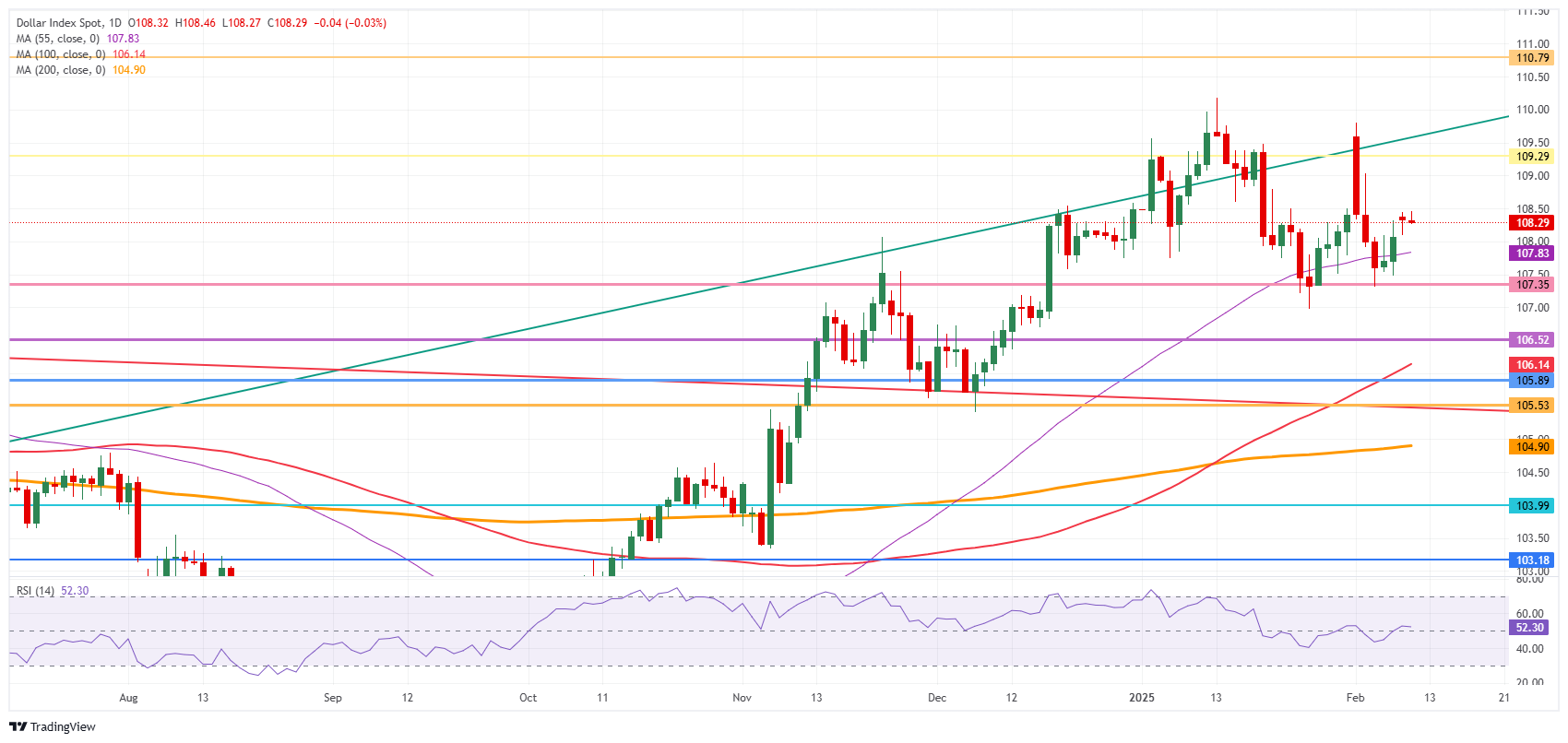US Dollar consolidates ahead of Fed Chairman Powell’s speech
- The US Dollar trades fairly flat for a second day in a row this week.
- All eyes are on Fed Chairman Jerome Powell heading to Capitol Hill.
- The US Dollar Index (DXY) is trading sideways above 108.00
The US Dollar Index (DXY), which tracks the performance of the US Dollar against six major currencies, is broadly flat and still resides above 108.00. The Greenback looks to be immune to US President Donald Trump's tariff talks. While China silently slapped some minor tariffs on US goods in a tit-for-tat move on Monday, Trump introduced a 15% levy on steel and aluminum for all countries importing that will come into effect on March 12.
The economic calendar this Tuesday is being taken over by the Federal Reserve (Fed). Besides Fed Chairman Jerome Powell testifying before Congress, three Fed speakers are due to make an appearance. Traders will want to hear if the central bank has plans for any changes in its monetary policy soon.
Daily digest market movers: A snooze fest
- At 11:00 GMT, The National Federation of Independent Business (NFIB) has released its Business Optimism Index for January. The number came in at 102.8, below the 104.6 estimate and down from 105.1 in the December reading.
- Fed Chairman Jerome Powell will keep his semiannual testimony before Congress at 15:00 GMT.
- More Fed speakers are lined out to speak throughout the day:
- At 13:50 GMT, President of the Federal Reserve Bank of Cleveland Beth Hammack will talk at the 2025 Economic Outlook Conference at the Central Bank Center.
- At 20:30 GMT, Federal Reserve Governor Michelle Bowman speaks at the Iowa Bankers Association Bank Management and Policy Conference in Des Moines.
- At 20:30 GMT, Federal Reserve Bank of New York President John Williams also delivers keynote remarks at the CBIA Economic Summit and Outlook 2025, organized by the Connecticut Business and Industry Association (CBIA) in Connecticut.
- Equities are struggling this Tuesday with the tariff hangover starting to weigh on them. All major European and US indices are in the red, though less than 0.5%.
- The CME FedWatch tool projects a 93.5% chance that the Fed will keep interest rates unchanged at its next meeting on March 19.
- The US 10-year yield is trading around 4.51%, ticking up further for a second day in a row and recovering further from its fresh yearly low of 4.40% printed last week.
US Dollar Index Technical Analysis: Tailrisk from Powell
The US Dollar Index (DXY) is really turning into a snooze fest this week. No real movement in the Greenback as of yet, despite plenty of headlines. Though US yields are the asset to monitor, with Powell’s testimony ahead, things might start to move from now.
On the upside, the first barrier at 109.30 (July 14, 2022, high and rising trendline) was briefly surpassed but did not hold last week. Once that level is reclaimed, the next level to hit before advancing further remains at 110.79 (September 7, 2022, high).
On the downside, 107.35 (October 3, 2023, high) is still acting as strong support after several tests last week. In case more downside occurs, look for 106.52 (April 16, 2024, high), 106.14 (100-day Simple Moving Average), or even 105.89 (resistance in June 2024) as better support levels.

US Dollar Index: Daily Chart
US Dollar FAQs
The US Dollar (USD) is the official currency of the United States of America, and the ‘de facto’ currency of a significant number of other countries where it is found in circulation alongside local notes. It is the most heavily traded currency in the world, accounting for over 88% of all global foreign exchange turnover, or an average of $6.6 trillion in transactions per day, according to data from 2022. Following the second world war, the USD took over from the British Pound as the world’s reserve currency. For most of its history, the US Dollar was backed by Gold, until the Bretton Woods Agreement in 1971 when the Gold Standard went away.
The most important single factor impacting on the value of the US Dollar is monetary policy, which is shaped by the Federal Reserve (Fed). The Fed has two mandates: to achieve price stability (control inflation) and foster full employment. Its primary tool to achieve these two goals is by adjusting interest rates. When prices are rising too quickly and inflation is above the Fed’s 2% target, the Fed will raise rates, which helps the USD value. When inflation falls below 2% or the Unemployment Rate is too high, the Fed may lower interest rates, which weighs on the Greenback.
In extreme situations, the Federal Reserve can also print more Dollars and enact quantitative easing (QE). QE is the process by which the Fed substantially increases the flow of credit in a stuck financial system. It is a non-standard policy measure used when credit has dried up because banks will not lend to each other (out of the fear of counterparty default). It is a last resort when simply lowering interest rates is unlikely to achieve the necessary result. It was the Fed’s weapon of choice to combat the credit crunch that occurred during the Great Financial Crisis in 2008. It involves the Fed printing more Dollars and using them to buy US government bonds predominantly from financial institutions. QE usually leads to a weaker US Dollar.
Quantitative tightening (QT) is the reverse process whereby the Federal Reserve stops buying bonds from financial institutions and does not reinvest the principal from the bonds it holds maturing in new purchases. It is usually positive for the US Dollar.

